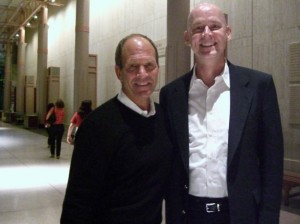Running on Empty

Running on Empty is the title of Marshall Ulrich‘s book about his run across America in the autumn of 2008, in which he covered 3,063 miles in 52 days at the age of 57 years old.
Marshall completed the third-fastest transcontinental crossing to date and set new records, too.
I got the book two months ago, when I met Marshall and heard him speak while he was in Houston for three days to promote it.
Pages Soaked with Emotions
… and Rum Punch!
I finished reading Running on Empty only yesterday, having taken it with me last month to Barbados to attend a wedding and subsequently but unwittingly soaking it with a bottle of rum punch that broke in the same piece of checked luggage on the flight home.
The wedding-related activities and the beauty of Barbados were so distracting that I never cracked open the book while I was there. But I was glad that I continued reading Marshall’s book once I got back home and let the punch-soaked pages dry.
Still, it took several sessions to get through Running on Empty — not because of the writing quality (It’s excellent!) but because it is a much deeper book than I had anticipated.
The emotions that Marshall expresses in Running on Empty are strong, and I believe that this book will resonate with any endurance runner or walker.
When you read it, you will feel as if you were out there on the road with him every single day.
Mental Tricks Galore
As the author of Mental Tricks for Endurance Runners and Walkers, I was especially keen to learn what mental tricks Marshall used to cover his 3,063 miles from the city hall of San Francisco to the city hall of New York.
I recognized in Marshall’s book several racing tricks that I cover in mine, including:
#1 – The Conversations Trick
#5 – The Anticipation Trick
#8 – The Environment Trick
#9 – The Be-Like-Mike Trick
#12 – The Pick-Off Trick
I recognized in Running on Empty other mental tricks that I cover in my book, too:
- “First Thing”
- “Memories”
- “Charity”
- “Good Example”
- “Tracking”
- “Race-Day Rewards”
- “The Importance of Celebrating…”
- “Be Kind to Yourself After…”
Happiness and Love
Besides Marshall’s emotions-charged “This is not my foot.” story about psychological dissociation, the mental trick that especially caught my attention in Running on Empty came from his advice that the support crew has a responsibility to ensure,
“The runner is as happy and content (and undistracted) as can be expected.”
THAT, to me, is the essence of your success as an endurance runner or walker — that you do whatever you can to be happy with the sport.
And, if you are as fortunate as Marshall to have the loving support of your partner — in his case, from his wife Heather — then you will not be endurance walking or running on empty.
So … if have you read Running on Empty, what would you say about it? Please leave a comment below!